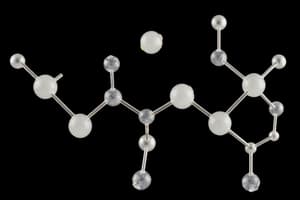Podcast
Questions and Answers
What is the naturally occurring enantiomer of glyceraldehyde?
What is the naturally occurring enantiomer of glyceraldehyde?
d-glyceraldehyde
How do you determine the D- or L-isomer of a carbohydrate with more than one chiral center?
How do you determine the D- or L-isomer of a carbohydrate with more than one chiral center?
Look at the chiral carbon farthest from the carbonyl group; if the hydroxy group points to the right, it is the D-isomer, and if it points to the left, it is the L-isomer.
What is the difference in physical properties between enantiomers?
What is the difference in physical properties between enantiomers?
None, they have the same physical properties.
What is optical activity?
What is optical activity?
Signup and view all the answers
What is the difference between a levorotatory and a dextrorotatory substance?
What is the difference between a levorotatory and a dextrorotatory substance?
Signup and view all the answers
Why are chiral molecules important in biological systems?
Why are chiral molecules important in biological systems?
Signup and view all the answers
What is an example of a carbohydrate that is found in living muscles?
What is an example of a carbohydrate that is found in living muscles?
Signup and view all the answers
What is the significance of D-monosaccharides in human metabolism?
What is the significance of D-monosaccharides in human metabolism?
Signup and view all the answers
What is the significance of L-amino acids in protein synthesis?
What is the significance of L-amino acids in protein synthesis?
Signup and view all the answers
What is biochemistry?
What is biochemistry?
Signup and view all the answers
Study Notes
Biochemistry Overview
- Biochemistry focuses on chemical substances in living organisms and their interactions.
- It examines the structure and function of cellular components including proteins, carbohydrates, lipids, and nucleic acids.
Carbohydrates Definition and Characteristics
- Carbohydrates are defined as aldehyde or ketone derivatives of polyhydroxy alcohols.
- Major energy source from the diet, composed of carbon (C), hydrogen (H), and oxygen (O).
- Also known as saccharides, meaning “sugars.”
- Produced through photosynthesis in plants; glucose synthesized from CO2, H2O, and sunlight.
Biological Importance of Carbohydrates
- Provide energy through oxidation.
- Supply carbon for building cellular components.
- Act as stored chemical energy.
- Contribute to the structure of some cells and tissues.
Classification of Carbohydrates
- Monosaccharides: Single sugar units (e.g., glucose, fructose).
- Disaccharides: Two monosaccharides linked (e.g., sucrose).
- Oligosaccharides: 3 to 10 monosaccharides (e.g., raffinose).
- Polysaccharides: Long chains of monosaccharides (e.g., cellulose, glycogen, starch).
Stereochemistry of Carbohydrates
- Glyceraldehyde, the simplest carbohydrate, has two mirror-image forms (stereoisomers).
- Isomers have the same chemical formula but differ in structural arrangements.
Chirality and Handedness
- Chiral molecules cannot be superimposed on their mirror images (e.g., left and right hands).
- A carbon atom is chiral if it is bonded to four different groups.
- Compounds with chiral carbons may have multiple stereoisomers.
2n Rule
- The maximum number of stereoisomers for a molecule with n chiral carbons is 2n.
Fischer Projections
- A two-dimensional representation to illustrate chirality centers in carbohydrates.
- Glyceraldehyde has one chirality center, resulting in two enantiomers, d-glyceraldehyde and l-glyceraldehyde.
Sugar Isomerism
- When identifying chiral centers, the farthest chiral carbon from the carbonyl group helps determine D- or L-isomer status.
- D-isomer has the hydroxy group to the right; L-isomer has it to the left.
Optical Activity
- Enantiomers have identical physical properties but differ in interactions with polarized light.
- Levorotatory (–) substances rotate light left; dextrorotatory (+) rotate light right.
- Biological systems often use only one stereochemical form — e.g., L-lactic acid in muscles vs. D-lactic acid in sour milk.
- Humans metabolize D-monosaccharides, while only L-amino acids are incorporated in protein synthesis.
Assignments
- Define biochemistry.
- Discuss the importance of carbohydrates.
- Classify carbohydrates with examples.
- True or False:
- The simplest carbohydrate is glyceraldehyde.
- Glyceraldehyde is a chiral molecule.
- Carbohydrates include sugar only.
Studying That Suits You
Use AI to generate personalized quizzes and flashcards to suit your learning preferences.
Related Documents
Description
Test your knowledge on the stereochemistry of carbohydrates, including enantiomers, chirality, and optical activity.




